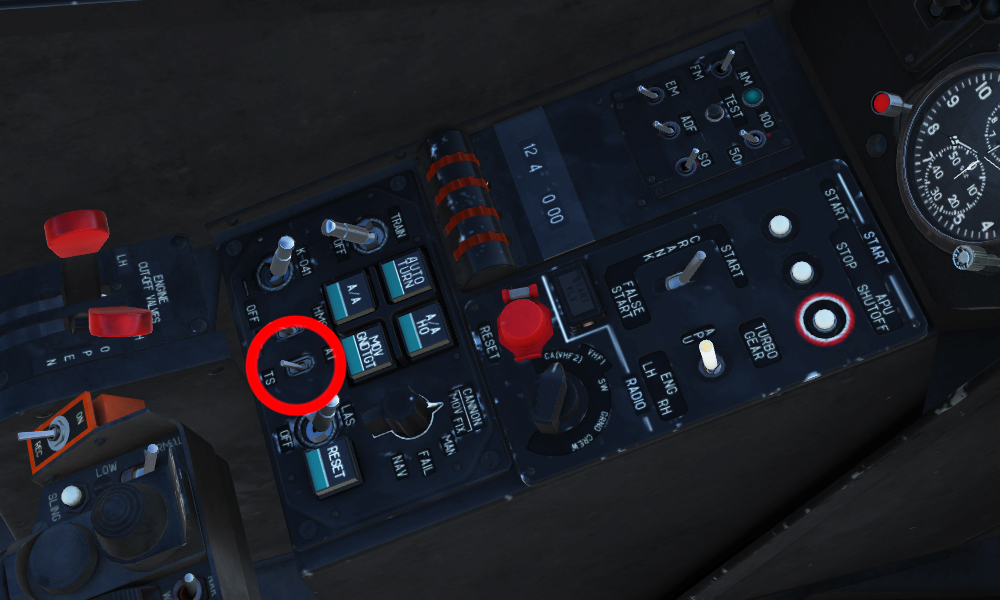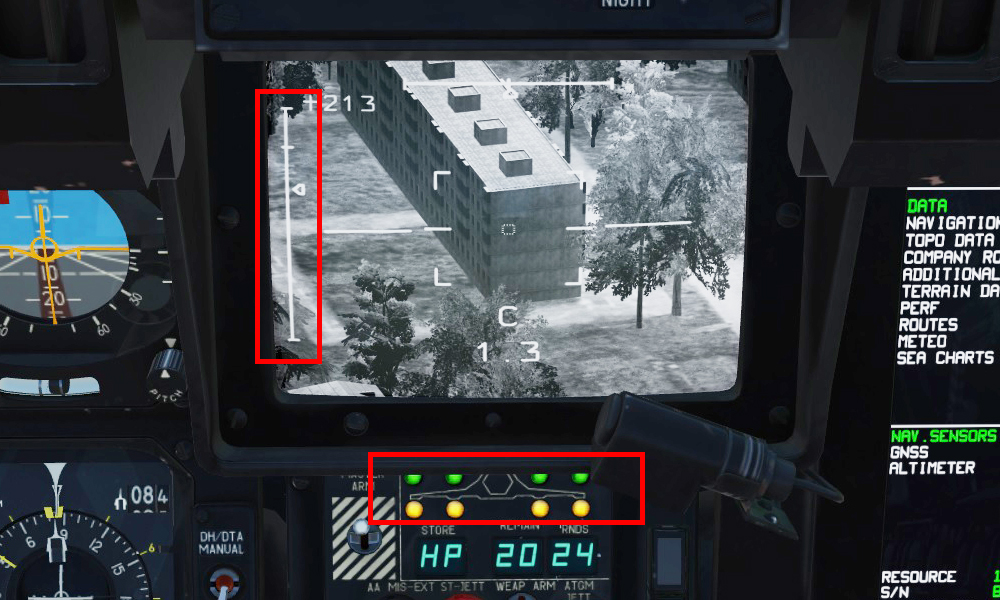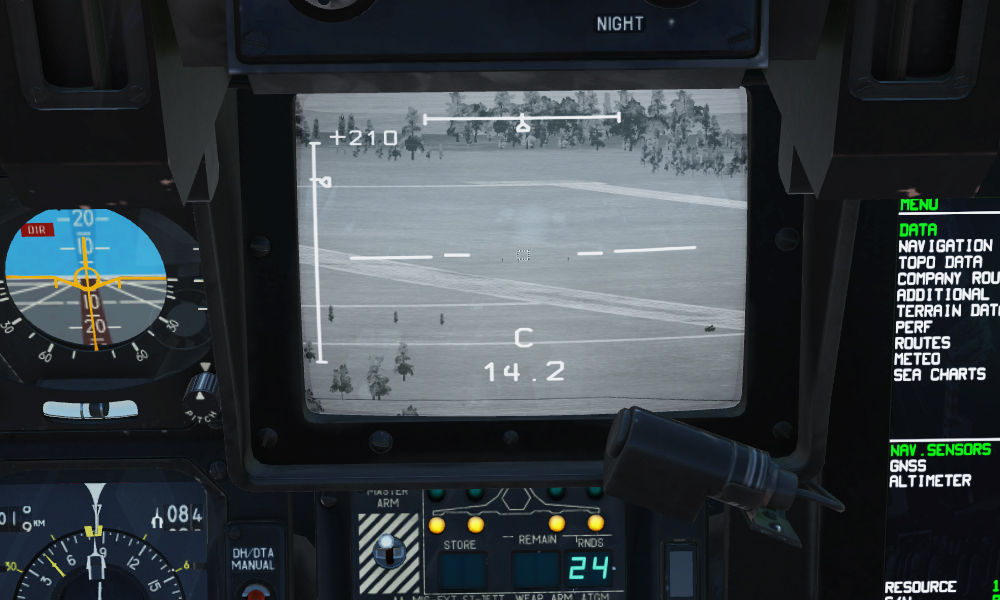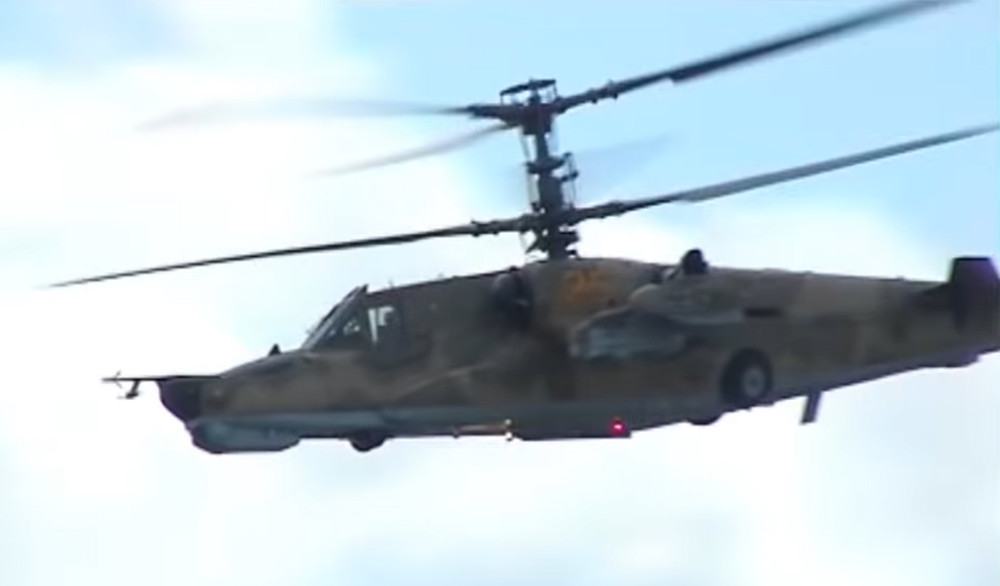-
Posts
63 -
Joined
-
Last visited
Content Type
Profiles
Forums
Events
Everything posted by Cheetah7798
-
This may be completely unhelpful, but the truth is, my experience with the issue is extremely limited (Happened once in an editor mission that I was testing on Syria for the first time) Long story short, I placed a Ka-50 at Bassel al-Assad airfield on one of the helicopter pad positions, yet after mission start it automatically moved the aircraft to a different start position on one of the primary aprons. This caused a Nav Error message to prompt on EKRAN. It must be said, though, that I didn't think to check the other information on the ABRIS, so I can't tell you if the scenario is an exact match. The solution for me was adjusting the start position so that the aircraft actually took off from where I'd placed it in the editor (I.E. I picked a parking spot on one of the aprons).
-
Only one I can really answer for sure. No idea when it changed, but the Su-25 and 25T now require a ~3 minute alignment period after engine start; Otherwise the compass is off by some ridiculous amount. Not sure how relevant this is, but I think the Su-25A's nav system only allows for 3 waypoints. There are 4 navigation modes: 'Nav', 'Return', 'Landing' and 'None'. Pressing '1' will cycle these modes, while pressing the 'next waypoint' key will increment the waypoints, or (if you are in return mode) it will cycle the different airfields. At least, that's how it works in the Su-27. PS: If you're getting into the Su-25A, just a word of warning. CCRP mode is (and has been for a while) a little hit and miss. Sometimes the aircraft will enter CCRP mode on trigger hold, sometimes it will just instantly drop your ordinance. Best to just stick with CCIP and be sure it'll work as intended.
-
Below are the weapons panel settings for launching S-5 rockets: Note that the ranging needle is about mid-way. Just out of frame is the 'break attack light', which is on, and mutually exclusive with the launch light, which is off. EDIT: Just to add, all I did was put a Player-controlled MiG-21 into the mission editor, gave it some S-5 rockets, and set the weapons panel switches to the positions shown above. All worked as intended.
-
I think this road was been travelled a good number of times now. The Ka-50 was not a helicopter which was mass produced by any means, and was, to an extent, a test platform that fielded and proved the functionality of a lot of systems that went on to appear in the Ka-52. From what I gather, the fact that it was modelled at all was due to a connection ED had with some pilot(s) / Engineer(s) relevant to the project. Talking about weather the Ka-50 (#25 or otherwise) was or wasn't modified to utilise the Igla, a DIRCM or an RWR is beside the point. Maybe it's just me, but there seems to be an inherent lack of ability to read between the lines here. ED cannot, despite its best efforts, produce a modern Russian module due to one or multiple Russian laws on information gathering. I get the notion that BS3 was supposed to be an attempt to circumvent that. Obviously, any attempt to model the Ka-52 directly would be in vain, so perhaps they thought to improve the Ka-50 with some not-too-far-fetched technologies that have been fielded in the Ka-52, and had at least been theorised to work for the Ka-50. Hell, they've put cutting edge DIRCMs on Mi-24s; There is no doubt that rigging one for a Ka-50 would be within the realm of possibility. Is it true to life? No. Is it possible? Yes. Is it believable? Yes. Would it have made the Ka-50 some kind of uber-weapon, the likes of which no one had ever seen? I think not. Ignoring, for a moment, the fine-print that separates reality from believable fiction; BS3 would have been (in my eyes) a kind gesture by ED to the many DCS patrons longing for a modern Russian module. I wasn't about to scoff at its inability to mimic reality, nor was I going to boast that the once-to-be newly modelled Kamov was a proper representation of reality. It was merely the most realistic possibility (from a development standpoint) for seeing a modern Russian aircraft in DCS. So, as unrealistic as BS3 would have been, I still feel a little sombre that it won't be taking shape after all this waiting.
-

Flight Model Characteristics - Will I be disappointed?
Cheetah7798 replied to Dangerzone's topic in DCS: Mi-24P Hind
TL;DR: Fly it, even if you dislike it, and eventually it'll come round. Or don't; Up to you. Yes and no. I don't know if you've ever flown the Mi-8 unloaded in DCS, but that thing has more energy than in ought to based on its size and looks. You touch the collective and it practically springs into the sky. Also, with the exception of poor transitions to hover, it never seemed to run out of 'give' when I'd performed short-sighted manoeuvres that should have ended in a flaming wreak. Also note, flying the Mi-8 with weapons on all 6 pylons doesn't lend itself to being agile. If you're flying the thing with 6 full S-8 pods, it'll feel like a bus. IRL, you rarely see them with more than a single pair of pods, or occasionally, a set of S-8s and UPK-250s (a la the Mi-8 loading screen). I held a decent amount of disdain for helicopters in general in DCS, until I put the time in to actually learn how to treat them and employ them properly. The Mi-8 was no exception. Since my first rotorcraft was the Ka-50 (arguably the staple for flight stability in DCS helicopters), transitioning to the Mi-8 was like getting slapped in the face and being told I didn't know how to fly helicopters, and never did. Long story short, merely spending time with the Mi-8 breeds a certain level of understanding and respect for its capabilities. Now I really enjoy it; And, to put it into perspective, I started flying the UH-1H long after the Mi-8, and my initial opinion was reversed to yours. I didn't enjoy the Huey's 'instability', for lack of a better term. It was always yawing or bobbing or slipping. It didn't want to fly fast and when you made it, it didn't like you, ramping up the yawing, bobbing and slipping to 11 until you brought it back down to a reasonable speed. I get it, it's a very 'raw' helicopter experience. No level of assistance like the Mil or Kamov. Some people go in for that, and in time maybe I will; But, for now I just find it irksome. -
You know what, in hindsight that makes a lot of sense. I read "Fired Shkval" in DthFrmAbv's message, thinking he meant firing the laser. In that case, if you're having trouble with your Vikhrs falling short, or going nuts, here's the list of things to check (Feel free to ignore if I'm just telling you what you already know): - Laser overheated (Requires aircraft repair): Text appears on the bottom-centre of the HUD (Forgotten what it said, exactly. It's been a while since I've seen it). Attempting to lase something results in the cool-down timer (Bottom-left of HUD) appearing then disappearing immediately. - Poor Alignment of the reticles: If the Vikhr's reticle isn't close to the Shkval reticle (within ~1-2 deg) their attempt to re-enter the laser beam after launch can be so harsh as to shoot right through it and off into infinity. You want to slot the Shkval reticle right in the centre of the Vikhr's reticle if possible. Do note, while the Vikhr pylons do pitch down, they don't yaw, so you'll have to manually rotate the platform. - Out of range: If the range to the target is 8+ km, then there is the chance that they lose control authority just before impact (~8.5-9km) or drop off the Shkval screen entirely (9+ km). This largely depends on altitude of launch, speed of launch platform and whether or not you're manually compensating for the drop, etc.
-
Sounds like you messed with the automatic tracking switch and were attempting to use rockets. The Ka-50 has an odd-ball CCIP/loft calculator for bombs and rockets, achieved by placing the automatic tracking switch in the down position, lasing a target and selecting a ballistic weapon. It pans the Shkval down 'x' number of degrees to predict the impact point. Lock: Auto Tracking off: Select rockets (S-13 in my case) Note that the Skhval automatically pitched down to the point indicated by the left box highlight in the last image. Aligning the (now fixed) shkval with the target will provide an approximate firing solution.
-
I should have specified, Minor drift around the point of lock I don't consider a bug; Merely accumulated tracking errors. The more radical ones, like suddenly tracking some trees in the foreground, or sudden, substantial changes to range data strike me more as a bug than INS error. My understanding is, even with a laser lock, the ranging information is instantaneous, since the Ka-50's laser doesn't like continuous usage. That is, after the range has been found and the Shkval aligned, it enters the normal INS stabilisation that it would be in with any other contrast lock. It's accurate at first, but I think we've all seen it suddenly return some ridiculous range reading after either minor slew adjustments or helicopter attitude changes. Sometimes even flying straight and level triggers it. Just the other day, I'd locked (via laser) a piece of terrain near some infantry and upon closing with the target, the range suddenly spiked form 2.5km to 8+km. This seems a bit too drastic to be some INS error accumulation. It's just never really bugged me, since re-ranging will immediately fix the issue. Let's agree to disagree, then. The way I see it, DCS is an entirely different beast to Racing simulators or anything else, really. The work goes into making an accurate, simulated replica of the real aircraft, more than anything else. The campaign and AI, while important additions, don't come close (in my eyes) to the importance of the model's implementation as an isolated factor. Though, I'm willing to say my view might be a little skewed, as I'm quite proficient with the mission editor, and don't mind getting involved with the lua, when required. Content in terms of the campaigns feels like a gimmicky addition, more than anything. Enjoyable when they work; Not the end of the world when they don't. However, more to the point, the reason I didn't want to associate the AI and Campaign problems with the Ka-50 is because they are not unique to the Ka-50. They plague every module, so dissuading people from buying the Ka-50 because of a global DCS issue seems dishonest to say the least.
-
Having flown the Ka-50 as my primary module for the best part of the last two years, and occasionally flew it for many years prior. Here's a comprehensive list of of 'bugs' that I've encountered which are consistently present: 1) Most recently, the Vikhrs pylons don't depress, requiring whole-aircraft depression. (I'm on stable, may have changed in beta) 2) Manual inputs in the PVI-800 don't account for altitude. 3) Datalink targets are (very) occasionally stored incorrectly. I've witnessed it once in the last couple weeks. 4) Shkval lock is archaic compared to other DCS modules. 5) Shkval can occasionally drift. I'd consider the AI issues as something altogether separate, as well as the issues with the campaigns, which for the record, are from a time prior to the Caucasus remaster. Despite this, the module is functioning as intended, albeit a little dated compared to more recent modules, as can be expected; and any other bugs I've missed must be so insignificant that I can't recall them readily. Now, despite owning numerous other modules, be they western, eastern, fixed-wing or rotor-craft, I keep coming back to the Ka-50, because I genuinely find it among the most entertaining and capable of the lot. It is as far from unusable as the majority of other modules.
-
Here's a video of 2 Ka-50s pelting it on a straight. (Best I could find). Attached is an image I randomly pulled from one of the fly-bys. In the image you can clearly see the underside of the upper rotor, and the upper side of the leading lower rotor (blurred shade just right of rotor mast), despite the downward angle of the viewer. I'm no expert on any of this, mind you. This is just what I've observed and thought it relevant to the tread. Edit: On second viewing, that blurred shape is probably on the close (retreating) side.
-
Volk's answer is on point. I notice a lot of people become caught up in the idea that every ground-attack aircraft is a tank-killer, when, in reality, that's more the exception to the rule. Don't get me wrong, rockets could stand to be more effective in DCS, though not for the reasons you may think. The whole MO of unguided rockets is a compromise between explosive output, area saturation and, most importantly, affordability. You see the Russian air force make use of them a lot because they are extremely effective for their price, which is dirt-cheap compared to anything precision guided. Remember, for most militaries, the goal isn't to make the best weapon there ever was; Rather, it's to make the most cost effective weapon there ever was. Now, under what circumstances would rockets be used in reality? Simply put, area targets. Clusters of vehicles, manpower and defensive positions. A typical sortie for an attack helicopter like the Mi-24 would be flying out to some arbitrary, hostile defensive position, unloading rockets haphazardly around the area, then heading home. Again, the primary target here isn't individual vehicles (especially not tanks), it's going to be strong-points. Logistics vehicles parked in close proximity. Infantry huddled together in some trench or another. Typical, light skinned stuff. Here's a little experiment you can run in DCS. Set up a little camp in the editor. Tents, trucks, infantry, bunkers, etc... Fill a 500-1000m2 area. Then, load up a Ka-50 with 4 lots of S-8OFP2 rocket pods, set the thing to a medium burst-length. Lase the place and, at about 4-5km, unload an salvo and adjust your shots visually, based on the impacts. I think you'll find the effectiveness to be adequate. The primary reason rocket effectiveness suffers in DCS is because, in reality, most of the time the rockets don't need to completely destroy their targets. Imagine an APC that's have its tires shredded into rubber streamers; or trucks that have their fuel-tank perforated in fifty different places, or tanks with their optics shattered and antennae damaged. Mobility or mission kills, etc. If that were modeled, then you'd see the true effect of unguided rockets.
-
Nice images, correct me if I'm wrong here, but it looks like there's a thread at the base of the warhead. Does this mean the boosters and the warheads are separate objects; and that one could theoretically mix and match warheads between boosters? I've long been aware of that. I was more (implicitly) getting at the fact that the S-8OFP2 currently in-game has a rather generous damage radius vs infantry; Quite possibly the blast damage you mentioned, but the KOM is effective almost exclusively via direct hits. I guess, in a round-about way I'm wondering what the major IRL differences are between the KOM and OFP2 variants, and whether what we see in-game is even a remote reflection of that reality. Practically speaking, the only time KOMs become viable in game are when you're targeting APCs, or mid-50s/60s MBTs, and due to the inherent inaccuracy of rockets, this task requires getting within guns range of the target in most cases; which is practically suicide for a helicopter. Less so for the Su-25, but still dangerous. For everything else, OFP2s take the podium. It feels as if the S-8KOM should settle in more of a middle-ground between where it is now, and where the S-8OFP2 is. But, I've got little to back that hunch.
-
While I'm inclined to agree with you on most of what you've said, I have a few points to raise. Number 1: The most common variant of S-8 used by the Russian AF is the S-8KO/KOM, typically labelled as a HEAT warhead, and it is; No doubting that. However, there are multiple sources which states that the rocket also has an additional fragmentation effect, the most viable of which is the official Russian arms export website, "Rosoboronexport", which has a neat little, dedicated paragraph to the S-8KOM, that states, and I quote: From memory, in DCS, S-8KOM rockets can land within mere metres of infantry and inflict little to no damage. Number 2: The S-24B loaded on the MiG-21bis differs substantially from the rocket by the same name loaded onto the Su-25A/T. Not sure why this is, but the MiG's version is notably more effective against just about everything, with a remarkably large fatality radius vs infantry. I'm curious which of the two versions is more accurate.
-

no radar missile launch warning in MP
Cheetah7798 replied to Banzaiib's topic in Su-27 for DCS World
I'm not contesting that. Detecting a missile launch is always going to be about consolidating information from as many launch indicators as possible, irrespective of missile type. Whether it's the RWR, visual ID (AMRAAMS leave a very subtle trail, visible at full-zoom if you know where to look), or just your perception of the situation as a whole. -

no radar missile launch warning in MP
Cheetah7798 replied to Banzaiib's topic in Su-27 for DCS World
From the testing I've done, any AIM-120 fired from a soft-lock will not be indicated on the SPO-15, or any other in-game RWR, for that matter. This is strategically problematic for a number of reasons, the most prominent of which is the response time you have when the AIM-120's seeker goes active. In the scenario I was testing (1.2M, 10,000 Metres, head-on), the response time was so small, that whether you made it to the notch bearing was hit or miss. Ultimately, the only solution I've found is to give the threat a side-ways look, placing them on the 65-70 degree limits of your radar. That way, you're already the majority of the way to the notch. This has the added benefit of allowing the AMRAAM to get real close, so if you do your job right and lose the missile, it has no chance of reacquisition, since it's already overshot. -

Is there a trick to rockets that I'm missing?
Cheetah7798 replied to aleader's topic in DCS: Ka-50 Black Shark
Just quickly. The Ka-50 (In Game) does this thing where, for the duration of trigger depression - with rockets selected - the aircraft will pitch-up rather rapidly. My guess would be that this is to facilitate dispersion for area targets; Never the less, it can be a pain to deal with for point targets. The 3 solutions I've discovered are as follows: - Pitch down during fire to compensate (Difficult) - Fire short bursts, or just tap the trigger (Better) - Enable flight director control as it completely disables the behaviour (best) EDIT: - Note that the behaviour is not 'recoil' from the rockets, since (last I checked) it still happens when you select empty pods. -

Is there a trick to rockets that I'm missing?
Cheetah7798 replied to aleader's topic in DCS: Ka-50 Black Shark
Only just skimmed over the thread, so not sure if this has been suggested, but it may be as simple as the rocket variant. I know The Ka-50 loadouts have a habit of loading the S-8KOM variant, which is the HEAT version, and is so close to useless I haven't really bothered using them. The only place I find them applicable is on the Su-25A/T, firing just before the minimum-range gate, but that's a whole other topic. Anywho, I'm just guessing here, but it might be worth rearming to load up the S-8OFP2 variant, which is actually quite respectable against infantry targets. Fire in bursts of 2-4, apply liberally to the hillside near the town and you're golden. EDIT - Extra notes: - For the approach to target, trim the helo out to be doing ~50-100km/h, point the Shkval in the rough area of the target, get a range and trust the reticle. Effective safe range of the OFP2 variant against infantry is between 3-6km - If you do manage to rearm with the OFP2 variant, make sure that you adjust the ballistic calculator selector on the rear-right panel. I believe the setting is 4 for S-8OFP2, though I can't readily remember. - If the trim is still giving you trouble, try engaging the flight director control (The 5th, right-most blue autopilot button). Generally, it makes the aiming process easier. -
Thought I might attach a few tracks to demonstrate. Though, I might mention that I am currently running the stable version, not the beta; Not sure if it matters. --- Ka-50_Rocket_Lob_01.trk No Wind Ka-50_Rocket_Lob_02.trk ~10m/s wind from 180 (Tail-wind) Ka-50_Rocket_Lob_03.trk ~10m/s wind from 270 (from 9 o'clock to 3 o'clock) --- NOTE: All attempts were 1st try; These are 3 consecutive tracks with no attempts between.
-
That's fair; though I'd like to say that I was able to destroy a group of 20 infantrymen at a range of 8-10km, within a 100-200m^2 area using this method (Having only just figured out its existence). Sure, it's unorthodox, but understand that the point of this thread was merely to point out the capability. Also, I am well aware of the Ugroza system. Regrettably we do not see it in DCS, and even more regrettably, I haven't seen it in action from any source I know. Also, worth pointing out, I prefer the flight director mode because it does not adjust your trim from the previous stable state. I also happen to have it bound to one of my HOTAS buttons, so it's about as easy to engage as trim. That said, either works take your pick. 15km was merely for testing purposes, It was hardly my recommendation to use that distance as the benchmark of employing this method. It works well - enough - for ranges where the HUD reticle falls below the nose of the Ka. Also, about the bunkers. The original S-13 was designed as a bunker penetrator. The S-13OF (The variant modelled in DCS), however, is your standard, run-of-the-mill, HE-fragmentation rocket (Like the S-8OFP2, just bigger. Notice the common letters "OF" meaning "High explosive"). If you're trying to penetrate bunkers with the OF variant, you'd probably be disappointed with the results.
-
KOM? No reason to use those, even beyond 2km. OFP2, on the other hand, can be useful against clustered or dispersed infantry. I'm imagining an AA unit that is denying you access to a particular area and/or you find yourself out of Vikhrs; Something of that sort. Instead of flying home with full rocket pods, there is something you can use them for at least half-competently. Other rocket types, such as the illumination and smoke variants, stand to have some useful employment via this method; not that they are often taken, though. S-13s are also quite useful with this employment. Basically, it gives the S-8s and S-13s a greater stand-off range then would otherwise be expected.
-
NOTE: It is entirely possible that the following procedure is already known, however, I couldn't see it listed anywhere --- I was messing around with bombs in the Ka-50 the other day when I was struck by a thought. What if you can use a similar targeting system setup for rocket lobbing. Lo-and-behold, it actually works. Flicking the "Automatic tracking - gun sight" switch down, turning on the Shkval, lasing the target and then selecting rocket pylons will lock the Shkval into a firing solution for the rockets out to the lased range. Placing the target in the shkval's FoV (preferably close to the center) will yield - within reason - accurate shots. Tested out to the maximum lasing range of 15km, though it's damn near impossible to neatly place a target in view at those extreme ranges, since there is only so long you can keep the nose pointed up ~45 degrees before flying backwards. As a bonus note, I find it helps to turn on "Flight Director Mode" on the Autopilot panel, mainly because: - It fights you less while aligning the target and Shkval FoV. - It stops the Ka's nose-up tendency while holding the trigger.
-
After testing, it seems that R-27T/ET missiles will get course updates just like the R/ERs. Launches of T/ET missiles without a seeker lock, in weapon launch override mode will guide them out to the target until the seeker becomes active. This is inconsistent with what is stated on the Wikipedia page (And, I assume, the Su-27SK manual). This begs the question, does the T/ET have a datalink with the firing aircraft? According to this article by Air Power Australia, it appears to suggest that the Datalink is purely associated with the R/ER variants. --- https://www.ausairpower.net/APA-Rus-BVR-AAM.html ---
-
After reading the (en) wikipedia article on the R-27 series of missiles, my interest was piqued by a rather poorly written paragraph about the R-27T/ET under the 'variants' header which appears to suggest LOAL capability for the missile's T/ET variants. It references the manual for the Su-27SK export model, and sure enough, after cross-referencing what little I could, various essential pieces of information seemed to correspond. Specifically, the terms 'ППС', 'Р-27ЭТ1(Р-27Т1)' and finally '15 degrees'. That's about all I could translate if you want to call it that. Here are two snippets from Wikipedia and the manual. Hopefully not stepping on any server rules with this one: --- Wikipedia: https://en.wikipedia.org/wiki/R-27_(air-to-air_missile) Manual: --- Firstly, I can't read Russian beyond recognizing the characters, so it would be nice to know if the manual does indeed align with the Wikipedia article. Secondly, am I correct in understanding that this suggests, with a hard-lock, in PPS mode, with no seeker lock or 'LA', you may fire a T/ET missile in the target's general direction (+- 15 degrees) and expect a LOAL? Finally, does any of this work in DCS? As far as I'm aware, it doesn't. EDIT: - Fixed link
-
If you've ever messed around with the ABRIS in ERBL mode, placing the cursor over any part of the map yields altitude data. So, in a round-about kind of way, the Ka-50 does have access to terrain altitude data. I suppose that it's an entirely different story to have that interact with the PVI-800, though.
-
randomTOTEN, flanker0ne, thank you both for your input, though it is unfortunate that most of my suspicions about the system appear to be confirmed. Now, specifically responding to your questions, randomTOTEN: You are correct. Manual coordinate input of a target point into the PVI-800, then selecting it in operational mode. Turning on the Shkval will slew it to an inaccurate position (accurate at sea level). Now, from further testing, it appears manual input references a 2D plane at sea level. It's interesting to note, when you turn on the Shkval without a laser range, it still 'predicts' the camera's LOS intercept with the terrain on the ABRIS. Now, anyone who flies the Ka-50 knows that these predictions can be pretty far from accurate (Once again, because it makes reference to a 2D plane at SL). This can be confirmed since, once uncaged, the Shkval 'prediction' aligns perfectly with a manually input TP on the ABRIS, but the target won't be in sight. Getting a bit speculatory here, but IRL, how difficult would it be to cross reference the aircraft's 3D position, direction and Shkval angular offset with a 3D reference of the area to get an accurate LOS prediction? In any event, this has been interesting. Thanks, again.









